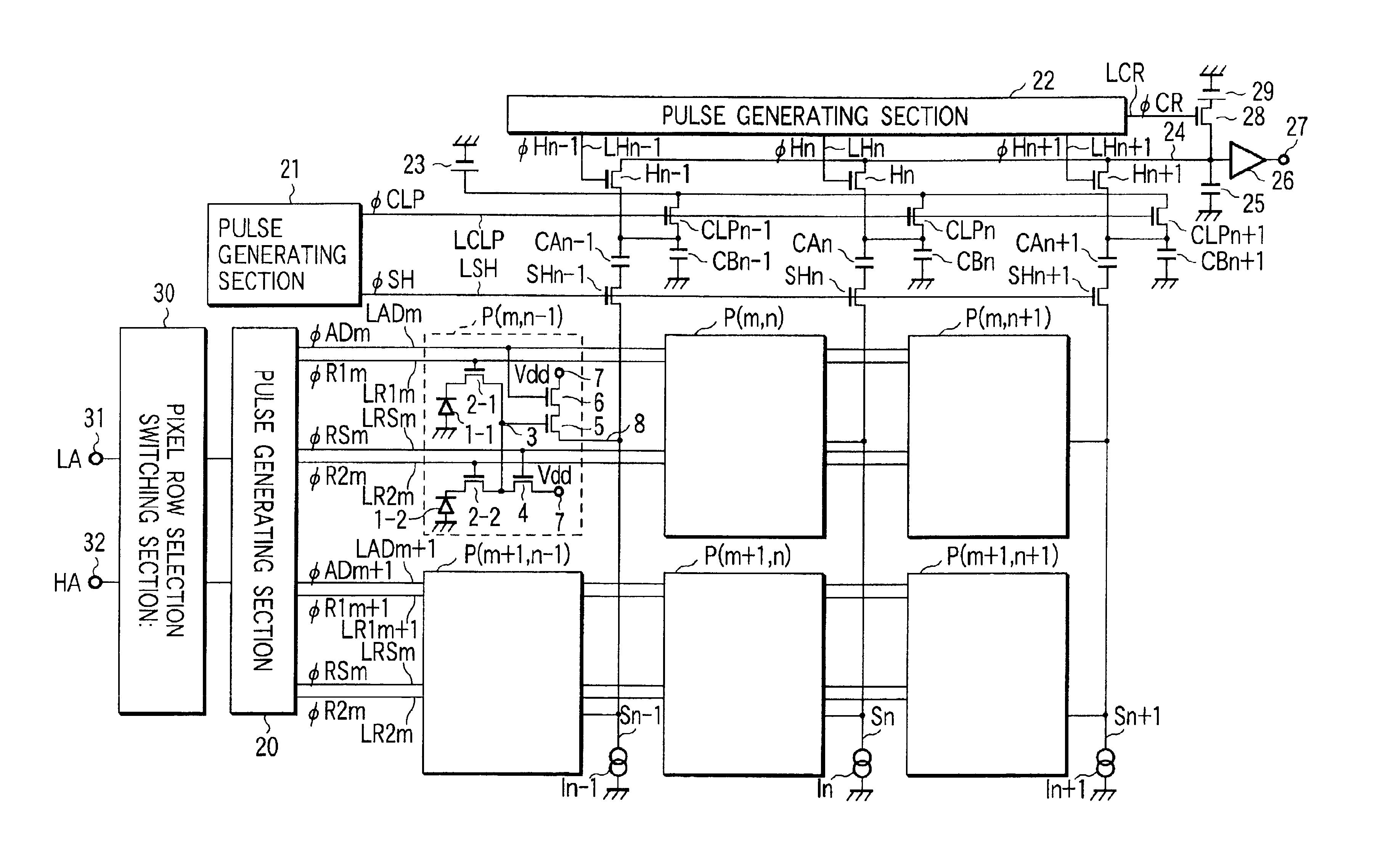Amplification type solid-state imaging device having a potential detecting circuit for each unit cell and high-speed readout method thereof
- Summary
- Abstract
- Description
- Claims
- Application Information
AI Technical Summary
Benefits of technology
Problems solved by technology
Method used
Image
Examples
first embodiment
[0053][First Embodiment]
[0054]FIG. 6 is a circuit diagram showing the construction of a solid-state imaging device according to one embodiment of this invention. Like the case of FIG. 1, in FIG. 6, a solid-state imaging device having two photodiodes arranged in each unit cell is taken as an example.
[0055]Unit cells are arranged in a two-dimensional fashion in an imaging area on a semiconductor substrate. More precisely, the unit cells are arranged in i rows and j columns, where i and j are integers. Of these unit cells, six representive ones are illustrated in FIG. 6. The six unit cells P are arranged in two adjacent rows m and m+1 and three adjacent columns n−1, n and n+1; they are located at intersections (m, n−1), (m, n), (m, n+1), (m+1, n−1), (m+1, n) and (m+1, n+1).
[0056]An address pulse line LADi, first and second readout pulse lines LR1i, LR2i and reset pulse line LRSi are arranged in the horizontal direction for each pixel row of the unit cells P(i,j). The unit cells P(i,j) ...
second embodiment
[0078][Second Embodiment]
[0079]FIG. 8 is a circuit diagram for illustrating a solid-state imaging device according to a second embodiment of this invention. The circuit is similar to that of FIG. 6 except that a pixel column selection circuit 40 and pixel column selection information processing circuit (decoder) 41 are provided instead of the pixel row selection switching circuit 30 and input terminals 31, 32 in the circuit of FIG. 6. A signal SCA for selecting a pixel column is supplied to and decoded by the pixel column selection information processing circuit 41 and the decoded signal SCA is supplied to the pixel column selection circuit 40. The pixel column selection circuit 40 controls the pulse generating section 22 and causes the pulse generating section 22 to output a horizontal readout pulse at different timings according to the high-resolution mode and high-speed driving mode.
[0080]Since the other basic construction is the same as that of the circuit of FIG. 6, like portio...
third embodiment
[0086][Third Embodiment]
[0087]FIG. 10 is a circuit diagram for illustrating a solid-state imaging device according to a third embodiment of this invention. The circuit is basically similar to that of FIG. 8 except that the control operation for controlling the pulse generating section 22 by use of a pixel column selection circuit 40′ and pixel column selection information processing circuit (decoder) 41′ is different, and as shown in the timing chart of FIG. 11, horizontal readout transistors arranged for every three unit cells are turned ON at the same timing. That is, signal charges are simultaneously read out from every third columns of unit cells by simultaneously setting the horizontal readout pulses φH1 and φH4, φH2 and φH5, φH3 and φH6, to the high level and the average value thereof is output.
[0088]Therefore, the average value is output at the pulse repetition rate of the horizontal readout pulse. The readout method described in the third embodiment is preferable for a const...
PUM
 Login to View More
Login to View More Abstract
Description
Claims
Application Information
 Login to View More
Login to View More - R&D
- Intellectual Property
- Life Sciences
- Materials
- Tech Scout
- Unparalleled Data Quality
- Higher Quality Content
- 60% Fewer Hallucinations
Browse by: Latest US Patents, China's latest patents, Technical Efficacy Thesaurus, Application Domain, Technology Topic, Popular Technical Reports.
© 2025 PatSnap. All rights reserved.Legal|Privacy policy|Modern Slavery Act Transparency Statement|Sitemap|About US| Contact US: help@patsnap.com



